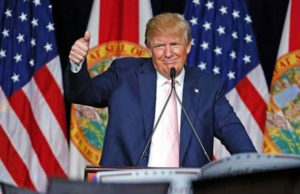
The morning rain that fell on Washington as Donald Trump’s election victory became clear was a fitting metaphor for the nation’s defense industry, because it appears the Obama-era drought in Pentagon demand for new weapons is over. Combined with Republican retention of majorities in both chambers of Congress, Trump’s win signals that the gridlock restraining increases in defense outlays will soon disappear, replaced by an eagerness to rebuild America’s military that necessarily entails major new investments in equipment.
President Obama has been reasonably supportive of the military during his tenure, but he has followed the typical vector of post-Vietnam Democrats in favoring personnel and readiness spending over weapons outlays. Surges in weapons spending usually require Republican control of the White House and Senate, which is what Washington will now have. Although Trump’s plan for massive tax cuts and belief that there is extensive waste in the Pentagon budget may limit weapons increases, here are some items sure to get funded.
First, Trump has repeatedly stated that he will modernize the nation’s aging nuclear arsenal, which consists of missile-carrying submarines, land-based missiles in Midwestern silos, and long-range bombers. The Obama Administration has nuclear modernization plans, but it hasn’t explained where the money will come from. Now, it is sure to come. Big winners: General Dynamics and Huntington Ingalls Industries which make subs, Lockheed Martin which makes sub-launched missiles, Northrop Grumman which is building a new bomber, and Boeing which builds tankers and airborne command posts to support the nuclear force. One of these companies will also be tapped to replace land-based Minuteman missiles.
Second, Trump has proposed significantly increasing the size of the Army and Marine Corps, which will require major equipping initiatives. Vehicle makers BAE Systems and General Dynamics will benefit not only from new production, but also upgrades to the existing fleet making it more lethal and resilient. Helicopter makers Boeing and Lockheed Martin will almost certainly get more money, as will companies like BAE Systems and Raytheon that provide radios, electronic warfare gear, and ground-based air defense systems.
Third, Trump has stated an intention to expand the Navy’s fleet to 350 warships from less than 300 today. That probably means buying aircraft carriers and surface combatants faster, which would be good news for General Dynamics and Huntington Ingalls Industries — the nation’s two leading producers of warships. The Obama Administration already has programmed fairly robust spending on Virginia-class attack subs (not to be confused with ballistic missile subs) which are built in partnership by GD and Huntington; Trump’s win will do nothing to undermine that plan, and may expand it. If the Marine Corps grows, Huntington Ingalls will also be building more amphibious warships.
Recommended by Forbes
Fourth, Trump’s defense plans call for a larger Air Force fighter force, which probably means a faster ramp-up in production of Lockheed Martin’s F-35 fighter. The Air Force is buying over two-thirds of the F-35′s domestic production run. Other variants of the plane will be needed to equip an expanded Navy fleet and the Marine Corps. Since Trump has stated frequently on the campaign trail that allies need to do more to support collective security, his defense policies will probably boost export sales of the F-35 and other planes like Boeing’s P-8A Poseidon maritime patrol aircraft. BAE Systems and Northrop Grumman are major subcontractors on the tri-service F-35, which is crucial to deterring war in Europe.
One question mark in Trump defense policies is how his affinity for Russian leader Vladimir Putin will impact plans to bolster U.S. forces in Europe. President Obama and his predecessor drew down U.S. forces in Europe to a point where they may have encouraged Moscow to exert greater military pressure on adjacent countries. In order to counter Russian moves, the U.S. Army would need more lethal and survivable armored vehicles on the ground in Europe, better counters to Russian electronic jamming and cyber attacks, and improved air defenses. The Army thinks war could occur in Europe within five years if it doesn’t field a more potent deterrent there; time will tell whether Trump buys that argument.
Source : http://www.forbes.com/


















